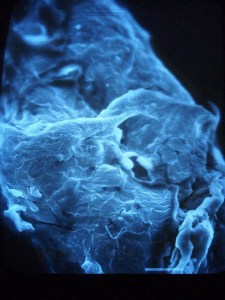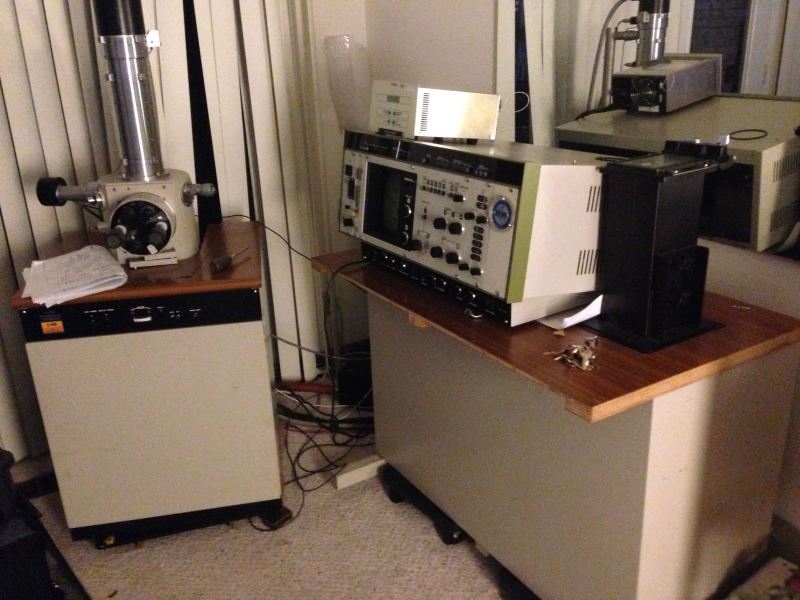There are hackers who have soldering setups on the dining room table, and then there are hackers who have scanning electron microscopes in their living room. [Macona] is part of the latter group, with a Hitachi S-450 SEM he’s repaired and modified himself. [Macona] has documented the whole thing on Hackaday.io. The Hitachi came to him and a friend as a derelict. First it was broken, then stored for 10 years. It turned out the problem was a high voltage cable cut and spliced with electrical tape. The tape eventually broke down and shorted out the 500V supply. Thankfully the rectifier diodes were the only parts that needed to be replaced.
 The SEM sprang to life and gave [Macona] and a friend their first images. However, SEMs are finicky beasts. Eventually the filament burned out and needed to be replaced. New filaments are $500 US for a box of 10, which is more than [Macona] wanted to spend. It turns out filaments can be built at home. A bit of .089mm tungsten wire and a spot welder were all it took to fix the issue. Next to go bad was the scan amplifier. While SEMs use many exotic parts, the Hitachi used relatively common Sanyo STK070 audio amplifiers for the purpose – an easy fix!
The SEM sprang to life and gave [Macona] and a friend their first images. However, SEMs are finicky beasts. Eventually the filament burned out and needed to be replaced. New filaments are $500 US for a box of 10, which is more than [Macona] wanted to spend. It turns out filaments can be built at home. A bit of .089mm tungsten wire and a spot welder were all it took to fix the issue. Next to go bad was the scan amplifier. While SEMs use many exotic parts, the Hitachi used relatively common Sanyo STK070 audio amplifiers for the purpose – an easy fix!
One thing that makes this SEM unique is the is Energy Dispersive X-Ray Spectroscopy (EDX) unit attached to it. The fragile liquid nitrogen cooled sensor was working, but the 1980’s era signal processing computer was a bit too old to bring up. A friend and fellow SEM hobbiest gave [Macona] a slightly newer Kevex Sigma Gold signal processor, which was nearly a plug and play upgrade for his machine. The new processor processor also gave him digital beam controls and a digital output which could be used to capture images with a PC.
Once all the connections were made, the EDX worked surprisingly well, even finding gold in a uranium ore sample placed in the microscope.
Now that old scanning electron microscopes being retired, it’s only a matter of time before more us get a chance to join the ranks of [Jeri Ellsworth], [Ben Krasnow] and [Macona] with our own personal SEMs!















Adam, just so we’re clear on this, I think most hackers would have an SEM in our living room if our wives would lets us.
That said, lets buy a bunch of uranium in hopes of striking it rich with gold? Probably won’t raise a red flag unless it’s 235 :)
To say nothing of our in-home-SEM-hating husbands.
Funny – my wife would want the SEM in the living room. I’m the one who would banish it to the basement – more to be sure the cats don’t try to use the column as a scratching post than anything else.
Don’t you need a pretty dust-free room for a SEM? Else you’d be scanning dust rather than the sample I think right?
Not really, you find SEMs in offices and labs and the like all the time with no special filtration.
LOL If the thing keeps breaking down in new ways, and it keeps getting repaired and documented, eventually we won’t even need to inherit a broken one. Looks like we’re well on our way!
Oh yeah, it will keep breaking. The data display module died the other night but came back. Lucky for me an extremely nice guy who was a Hitachi service tech sent me a copy of the service manual so now I have a full set of schematics and everything.
Be sure to scan and upload that manual somewhere if it isn’t online yet.
bonus meta-points for scanning the scanning electron microscope manual with the scanning electron microscope.
Yeah, it might even have some gold in it.
Yeah, that is something I have been meaning to do. Its about 300 single sided pages.
When I read the headline, I immediately thought of [Ben Krasnow] and his SEM:
http://hackaday.com/2014/09/03/ben-krasnow-hacks-a-scanning-electron-microscope/
Until a few years ago, we had a SEM of similar make at work. Though I’m IS and not one of the lab techs who works with the SEM, it’s my understanding that the EDS sensor crystals of this era are irreversibly damaged if ever allowed to warm to near room temperature. Ours had to have liquid N2 in it continuously, and when the reservoir once ran dry, asses were chewed and the crystal replaced. I don’t know how the effect of the damage, or whether it’s cumulative with every cold/warm cycle. It’s obvious that [Macona]’s EDS is working, but possibly not 100% correctly.
They can take being warm, the problem is that if they have been cold for a very long time and there is a slight leak in the dewar assembly for the sensor it will slowly capture gas in the foam lining of the dewar like a sorption pump. When the unit comes up from cryo temps the trapped gasses are released and the sensor the area normally under vacuum actually develops a positive pressure blowing out the beryllium window. Then you have to send the whole thing in for repair.
What will kill a EDX sensor is applying bias voltage (usually -500v) to the sensor while warm, it will deplete the lithium in the Si(Li) detector and again, you get to send it in for repair. That is probably what happened to yours, there was still bias voltage on the sensor when it warmed up. Modern units have a sensor on the dewar to shut off the HV when the LN2 gets low.
The friend who gave me the sigma controller is a Professor at PSU and he said they let their sensors come up to temp when they are not using it. Just make sure the bias cable is disconnected so no one accidentally applied power.
Thanks for the explanation, sounds like you’re well on top of it, and glad to hear it isn’t a necessity for to keep it filled with LN2 24/7. Your scenario for our failure sounds likely, we had our original computer (what a beast, I think it had some 500x 74-series chips) up until the day we retired the SEM, and the EDX was often left running overnight for hi-res scans.
Hobbyist! If “hobbiest” was a word, it would mean “most hobby.”
Wouldn’t hobbiest be about who is the truest hobbit?
Wow, go back to school bro. That would be hobbiest, not hobbyist. Ist suffix implies a person specializing in that field, not by aptitude, but by choice, and/or recognition.
I know one thing: I’m no jeri elisworth nor macona.
But I’m sure I have some hidden talent, somehow, somewhere, right? Yeah I bet I do, maybe, or not.
@macona I recently picked up a Cambridge Instruments Stereoscan 250 Mk 3, complete with backscattered electron detector, EDX and specimen current amplifier. It was fully working and in use, but after being moved I suspect it has picked up an electrical fault — though I’m going to re-check all the cabling one more time — and it’s only pumping down to 10-5 Torr (hoping it’s just that some moisture settled in to the column, but who knows…) Can you recommend any good forums/lists where an SEM novice can get advice?
There is a microscopy listserv, but I don’t know of any other forum that caters to the home hobbyist. Perhaps we should start one?
Here you go:
https://groups.google.com/forum/#!forum/home-sem-hobbyists
:)
I have read that fasting aids the immune system, as opposed to suppressing it as the article states.